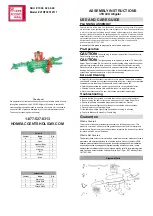
12
ENGLI SH
SAFETY INSTRUCTIONS
Read the User Instructions carefully before use.
Save these instructions for future reference.
Do not expose the helmet to high temperatures.
The helmet will be damaged if it is exposed to temperatures over 65°C. This temperature can be
exceeded in dark vehicles and storage cases during very hot weather. Heat deforms helmets and blisters
the surface structure. Discard a damaged helmet immediately and replace it with a new one.
Important information
The helmet is designed to absorb energy on impact, either by being destructed or damaged. The
helmet should be disposed of and replaced after an accident, even if it does not show any visible
signs of damage.
No helmet can provide protection from all kinds of accidents. Even accidents at low speed can lead
to serious head injuries and death, depending on the intensity of the force to which one has been
exposed.
Be careful and pay attention to what you are doing at all times when cycling, and make sure to read
these instructions.
The helmet is intended to be used for cycling and other similar activities.
It is not intended, and does not provide adequate protection for motor sports or riding a moped. No
helmet can protect the user from all types of accidents.
Do not modify the helmet or remove any parts, unless this is specifically recommended by the
manufacturer. The helmet must not be adapted, or fitted with accessories not recommended by the
manufacturer.
USE
This bike helmet complies with the requirements in SS-EN 1078: Helmets for cyclists, skateboarders and
roller skaters.
Protection and ventilation
The material in the outer shell makes the helmet very lightweight, but also very strong and hardwearing.
Ventilation openings with inner air channels allow the air to pass through the helmet for maximum cooling.
Adjusting with pads
The helmet must fit properly to provide effective protection. When the helmet fits properly it will not slide
backwards and forwards when the chin strap is fastened. If the helmet does not fit properly with the pads
inside it, remove them and fit different sizes of pads. You can mix different sizes of pads to obtain the
best possible fit for your head.
Straps and clasps
The bike helmet has a quick-release clasp, which is easy to use and does not alter the adjustment
of the straps.
The straps should fit tightly to the head and be evenly adjusted. Put the helmet firmly on your head
and fasten the clasp.
Check that none of the straps are loose. If so, take off the helmet and tighten the loose strap.
1.
To tighten the chin strap, hold the clasp in one hand and pull the strap through it.
2.
To tighten the back strap, pull strap number 1.
3.
Hold the helmet with one hand and hold the straps running under your chin with the other hand.
4.
Pull from side to side to adjust the length of all four straps.
































